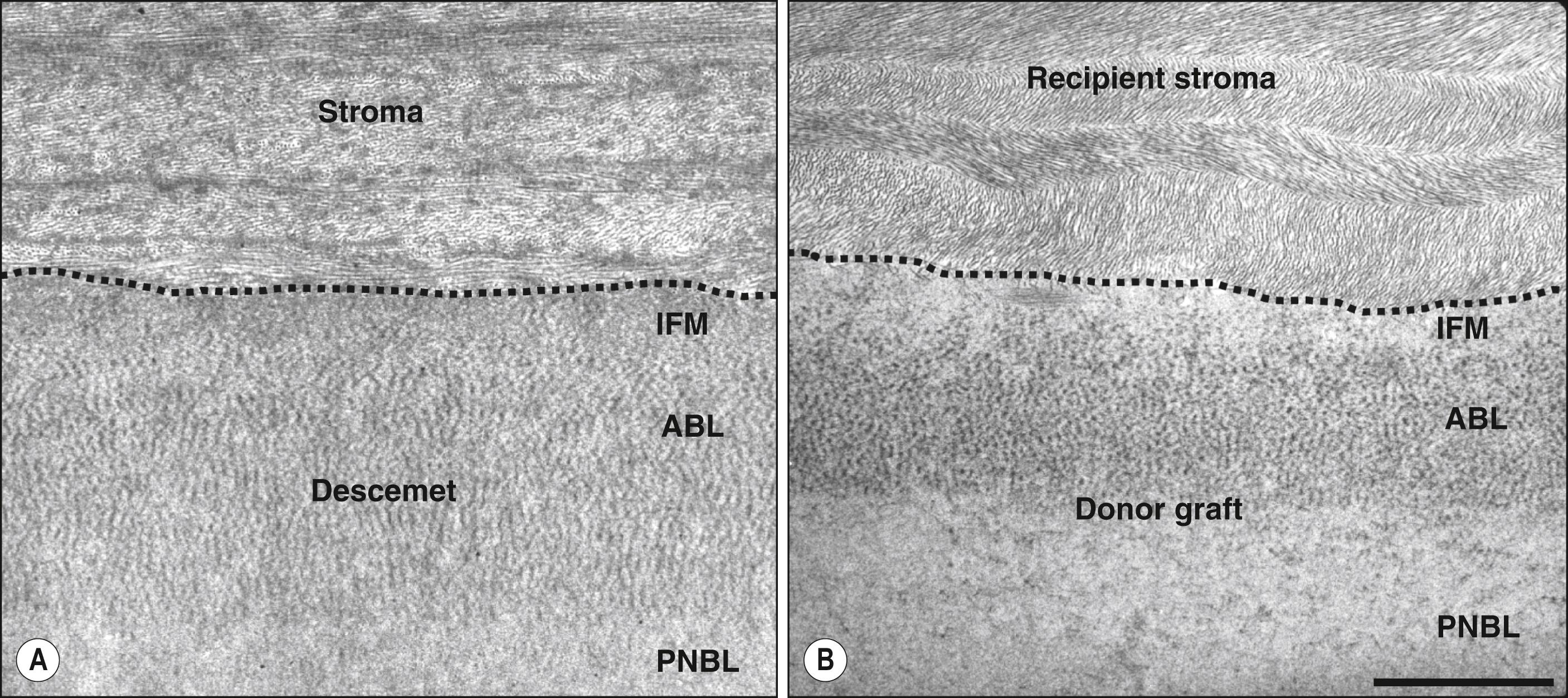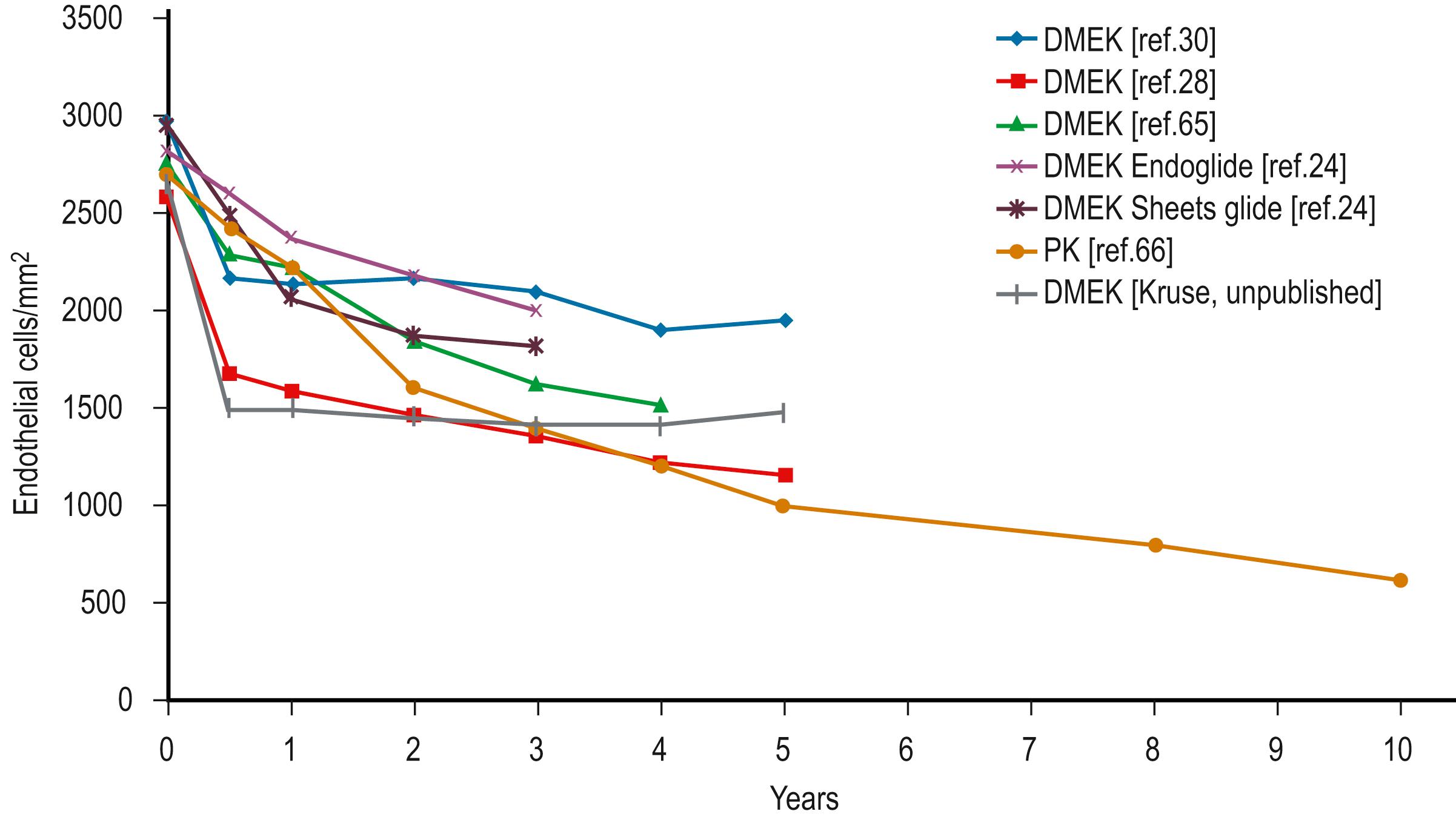Physical Address
304 North Cardinal St.
Dorchester Center, MA 02124
Descemet membrane endothelial keratoplasty (DMEK) offers improved functional results over many other techniques for posterior lamellar surgery.
DMEK reconstitutes normal corneal anatomy.
DMEK eliminates interface problems and reduces higher order aberrations of the posterior surface.
DMEK grafts can be prepared safely with reproducibility.
The risk of graft rejection is significantly lower after DMEK compared with rejection rates in Descemet stripping automated endothelial keratoplasty (DSAEK) or penetrating keratoplasty.
DMEK renders stable endothelial cell counts during short- and long-term follow-up.
Within the last decade, the concept of layer-specific substitution, although proposed some 60 years ago, has revolutionized corneal surgery more than any other subspecialty in ophthalmology. Selective substitution of Descemet membrane (DM) and endothelium has been made possible by the work of Gerrit Melles, who invented isolating DM from a donor and attaching it to the host using an air bubble: Descemet membrane endothelial keratoplasty (DMEK).
Reluctance to adopt DMEK has been due to the initial steep learning curve in the presence of other successful endothelial keratoplasty techniques such as ultrathin DSAEK. These techniques are perceived as being easier to perform due to the availability of standardized implantation techniques and precut tissue (see Chapter 130 ). Fortunately, DMEK has evolved in a similar fashion with improved tissue preparation, precut, and now preloaded tissue, as well as reliable insertion techniques. In many circumstances, DMEK has proven to be superior to other endothelial keratoplasty and, increasingly, surgeons are adopting this innovative technique.
In this chapter, visual function, preoperative, perioperative, and postoperative considerations surrounding DMEK surgery will be discussed. In addition, safety and reproducibility in comparison with DSAEK will be reviewed. Finally, postoperative complications, special considerations, and complex DMEK indications will be highlighted.
Improvement of visual acuity along with reduction of glare and haze as well as amelioration of color vision is the hallmark of DMEK surgery.
In a series of 500 patients, results for visual acuity were excellent: at 6 months. 75% of eyes reached ≥{20/25}, 41% achieved ≥{20/20}, and 13% ≥{20/18} (≥1.2) ( n = 418) when excluding eyes with ocular comorbidities. An analysis of 138 eyes without comorbidities showed equally convincing results: mean best corrected visual acuity (BCVA) at 1 year was {20/24}; 41% achieved {20/20}, 80% achieved {20/25}, and 98% achieved {20/30}. Analyzing 1700 DMEK procedures, Kruse et al. obtained similar results: at 3 months visual rehabilitation is completed; 95% of eyes see better than {20/40}, and 70% see better than {20/25}. In addition, both contrast sensitivity and color vision improve after DMEK.
Understanding the change in refractive power of the cornea after DMEK is critical in predicting visual recovery and managing patient expectations. This is particularly important in the setting of a combined cataract and DMEK procedure. Although DMEK does not significantly increase corneal thickness, Laaser et al. reported a hyperopic shift of +0.5 (±0.6 D) after DMEK. This hyperopic shift was also confirmed by van Dijk et al. (+0.33 ± 1.08 D) and Price et al. +0.49 (±0.63 D) in related studies. , Interestingly, Parker et al. found that phakic eyes undergoing DMEK had a slightly higher hyperopic shift of +0.74D. The hyperopic shift should be accounted for when trying to predict the refractive outcome for the patient.
The separation of DM from the stroma uses a natural cleavage between the corneal stroma and the interfacial matrix of DM. , Upon successful transplantation of the DMEK graft, the natural anatomy is reconstituted, making a grafted cornea indistinguishable from a normal cornea ( Fig. 137.1 ). Postmortem analysis of DMEK confirmed the picture of a “virgin” or unoperated cornea. Evaluation of stripped donor DM reveals large inter-individual variations of the inner surface of the graft. These differences explain variable adhesion rates of DM grafts.

As a general rule, the optical quality of the anterior corneal surface becomes almost normal in most patients after DMEK. Exceptions may occur if there was significant subepithelial scarring due and fibrosis. Nonetheless, it has been shown that patients with minimal anterior stromal scarring do not differ from controls with regard to higher order aberrations (HOAs) in the 4.0-mm zone. However, similar to DSAEK, subepithelial fibrosis, loss of keratocytes, and collagen disorganization may persist in some patients after DMEK. It is evident that anterior surface irregularities and haze are an important limiting factor in visual rehabilitation after DMEK due to increased HOAs.
Oyakawa et al. reported surface regularity of height (SR_H) as another potentially useful means of quantifying corneal irregularity before and after DMEK. It is correlated to total HOAs, as well as a direct measurement of total corneal irregularity using AS-OCT. This differs from the indirect means by which HOAs are measured using Schiempflug imaging. Anterior and posterior SR_H have been shown to improve after DMEK, with a statistically significant directional correlation with BCVA. This may help surgeons index the predictive quality of refractive outcome prior to and after DMEK.
When investigating causes for unsatisfactory visual recovery after DMEK, corneal irregularities and/or central corneal scarring were found in 8% of patients. Nine percent showed subnormal spectacle-corrected distance visual acuity (CDVA) and/or monocular diplopia due to corneal scarring, surface irregularities, or undetectable optical imperfections. These patients were managed with contact lens fitting. Surface problems are more likely to occur after severe edema, and prolonged preoperative corneal edema (>12 months) is a risk factor for irregular astigmatism after DMEK.
Epithelial and subepithelial pathology after DMEK may be prevented by epithelial debridement with mitomycin C application during DMEK surgery.
The optical quality of the posterior cornea by means of HOAs improves after DMEK. Normal values for Z 4 2 , Z 6 0 , Z 6 2 , and Z 6 4 in the central 4.0-mm zone were previously shown. However, combined values for HOA in the 4.0-mm zone were significantly higher after DMEK. In the 6.0-mm zone only tetrafoil (Z 4 4 ) increased after DMEK. Increase in Z 4 4 may have been caused by the corneal tunnel in the 12 o’clock position in that study. Thus DMEK restores the optical properties of the posterior surface to near normal. In a similar study, van Dijk et al. described higher values of posterior HOAs (root-mean-square [RMS] third to sixth Zernike order), as well as backscattered light after DMEK.
One of the most critical questions determining the future use of DMEK regards longevity and function of the grafted endothelium. It has been thought that endothelial cells after DMEK migrate from the donor tissue onto the host, possibly allowing rearrangement of the grafted endothelium. Furthermore, the grafted endothelium must maintain its original transcription program after transplantation (phenotypic differentiation), which is not the case after failed DMEK when myofibroblastic transdifferentiation occurs.
Large trials have confirmed a slow but continuous loss of endothelial cells after penetrating keratoplasty (PK), even if surgery was performed under optimal conditions and without risk factors (see Chapter 114 ; Fig. 137.2 ). In DSAEK, there is a relatively high initial endothelial cell loss followed by a more gradual depletion, which is even slower than in PK (see Chapter 134 ; see Fig. 137.2 ).

In DMEK, there is a significant loss of endothelial cells associated with graft preparation and shipment, as well as insertion and manipulation. This drop in endothelial cell count was most severe in the initial phase of the development DMEK. In his first report, Melles described a reduction from 2610 (±147) cells/mm 2 to 2030 (±373) cells/mm 2 at 6 months. Similar data stem from the early series of Price describing an endothelial cell loss at 1 year of 36 ± 20%, with most of the loss occurring during the first 3 months (31 ± 18%). Another study concerning initial experience showed a cell loss of 39% at 3 months and of 40% at 6 months.
The major factors determining cell loss in DMEK is surgical trauma, rebubbling, and rejection episodes. For novice surgeons cell loss at 6 months was 46% or 47%. , In contrast, careful preselection of patients, advanced technique, and surgeon experience can limit endothelial cell loss to 19%.
Thus increased technical skills and know-how continue to reduce cell loss in major centers. The latest report from Melles’ group describes a decrease in endothelial cell density of 35% at 6 months, 38% at 12 months, 43% at 24 months, 47% at 36 months, 52% at 48 months, and 55% at 60 months. This represents a significant decrease in the first 6 months, followed by a yearly decrease of only 7%. However, patient numbers for the 4- and 5-year follow-ups were very low (25 and 9, respectively), limiting the power of the study (see Fig. 137.2 ). In a short-term study by Price et al. investigating 492 patients, the mean endothelial cell loss remained stable at 26% between 3 and 6 months. In a long-term study, the same group reported an endothelial cell loss of 27% at 3 and 6 months as well as 1 year, 28% at 2 years, 31% at 3 years, 36% at 4 years, and 39% at 5 years. Out of 637 DMEKs in this study, 28 completed a 5-year follow-up, which limits the power of this study (see Fig. 137.2 ).
Price et al. evaluated 5 year data in 2017 consecutive cases of DSAEK and DMEK (1312 DSEK and 705 DMEK) and found that the mean ECC in DMEK was comparable to DSAEK with a cell loss of 47% ± 19% for DMEK and 48% ± 19% for DSAEK. Not surprisingly, graft rejection episodes increased endothelial cell loss; however, this was not predictive of graft failure within 5 years in either group.
There are differences between Europe and the Americas regarding tissue handling for corneal grafting. While the law requires organ culture in Europe, eye banks in the Americas and Asia use preservation media at 4°C. Fortunately, the evidence confirms that both techniques are suitable for DMEK and that grafts from organ cultured donors stick slightly better to the recipient for unknown reasons.
Recent studies in DSAEK evaluating the corneal preservation time and preoperative characteristics of the donor tissue have been investigated and may be extrapolated to DMEK. According to the Corneal Preservation Time Study (CPTS), preservation time can be extended to as long as 11 days, and avoiding donors with preexisting conditions such as diabetes should be considered during donor selection. However, donor tissue selection remains surgeon dependent.
Become a Clinical Tree membership for Full access and enjoy Unlimited articles
If you are a member. Log in here